獐Chinese Water Deer
1. 分类Taxonomy
鹿科Cervidae
獐属Hydropotes
獐Hydropotes inermis(Swinhoe,1870),英文名Chinese Water Deer
2. 保护级别Conservation Assessment
l 国家二级重点保护野生动物
National second class key protected species of China
l IUCN红色名录易危物种
Vulnerable (VU) species on IUCN Red List
3. 形态特征Physical Description
獐为小型鹿类,头体长90-105厘米,体重14-17千克。四肢粗壮,肩高略低于臀高。浑身体毛为棕黄色,腹部、颈部、臀部毛色较浅(图1)。
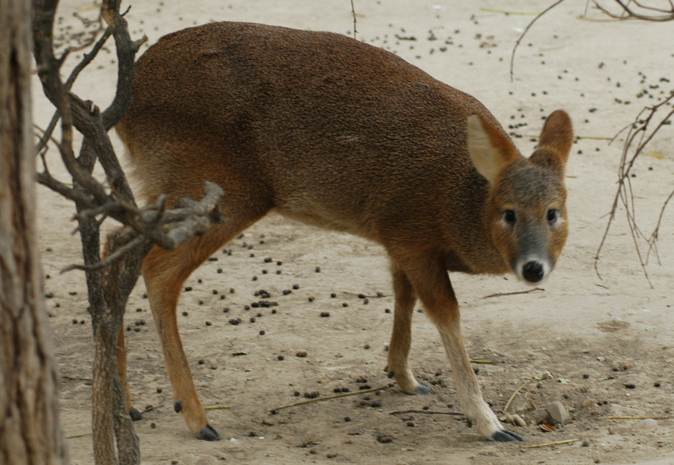
图1. 獐实体示意图(作者David Blank,来源Animal Diversity Web)
Figure 1. Chinese water deer (contributor: David Blank; origin: Animal Diversity Web)
两性均无角。
雄性上犬齿长而侧扁。向下突出口外形成明显的獠牙。獠牙真正的作用,通常是用来争夺领地与心仪姑娘的武器(图2、3)。
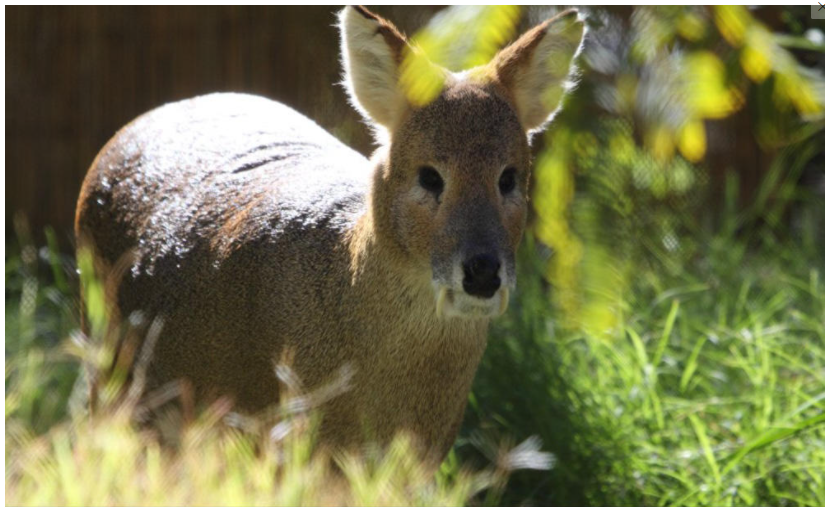
图2. 獐面部示意图(作者Brent Huffman,来源IUCN)
Figure 2. The face of Chinese water deer (contributor: Brent Huffman; origin: IUCN)
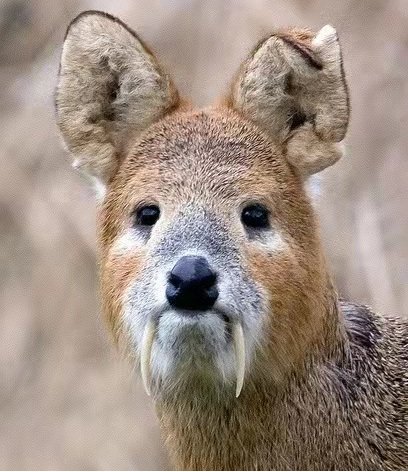
图3. 獐牙示意图(来源不明)
Figure 3. The elongated upper canine of water deer (origin: unknown)
尾极短,几乎被臀部的毛所遮盖。相比于小麂十多厘米的尾巴,獐的尾巴短,约2-9厘米。
Chinese water deer is a small deer species with a body length of 90-105 cm and a weight of 14-17 kg. The limbs are stout and shoulder height is slightly lower than hip height. The hair on the body is brownish yellow, and the hair on the abdomen, neck and buttocks is lighter (Fig. 1).
Both sexes have no antler.
The upper canines of male are long and laterally flat. Protruding down from the mouth to form a distinct tusk. The real use of tusks is usually a weapon used to fight for territory and females (Fig. 2, 3).
The tail is extremely short and almost covered by the rump hair. The tail of the water deer, about 2-9 cm, is shorter compared to the muntjac's tail, which is more than 10 cm.
4. 地理分布Geographic Range
獐史前曾经广泛分布于黄河流域及其以北的广大区域,后因气候变迁导致的自然环境变化以及人类开垦和狩猎等因素,向北退缩至黄海沿岸的辽宁半岛、朝鲜半岛,向南退居到现在亚热带的长江中下游和东部沿海一带。獐当前的分布区分为相互隔离的南北两片:北部位于朝鲜半岛西部至我国辽宁半岛,南部位于我国华东地区(图4)。
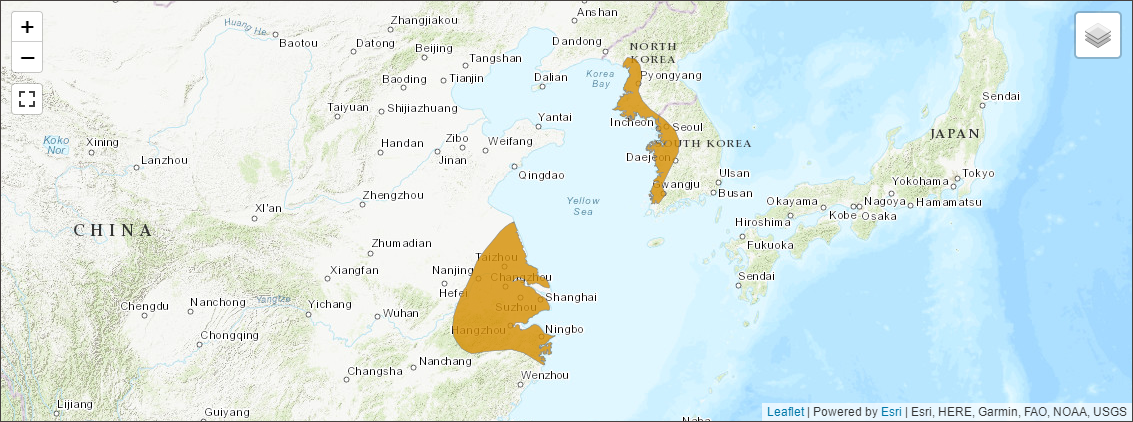
图4. 獐世界范围分布图(来源IUCN)
Figure 4. Geographic range of Chinese water deer around the world (origin: IUCN)
在中国,獐分布于辽宁、浙江、上海、江苏、安徽、江西。
此外獐还被人为地引入欧洲的英国和法国。
Chinese water deer once widely distributed in a vast area including the Yellow River basin and north of it in prehistoric period. After the changes of the natural environment as a result of climate change and human factors such as reclamation and hunting, their geographic range went north to the coast area of the Liaoning Peninsula, the Korean Peninsula off the Yellow Sea, south to the middle and lower reaches of the Yangtze River and the eastern coastal area in subtropic. The distribution of Chinese water deer is divided into two isolated regions: the north is located in the west of the Korean Peninsula to the Liaoning Peninsula of China, and the south is located in the East of China (Fig. 4).
In China, Chinese water deer is distributed in Liaoning, Zhejiang, Shanghai, Jiangsu, Anhui and Jiangxi provinces.
In addition, Chinese water deer was artificially introduced to Britain and France in Europe.
5. 栖息环境Habitat
獐亦被称为河麂,主要栖息在坡度平缓、临近江湖的河流下游和海岸沼泽生境中。栖息地选择随环境水位变化而不同。丰水期多在浅丘稀树灌丛中,枯水期则选择沼泽湿地、高草丛、芦苇丛。
The Chinese water deer mainly inhabit in the lower reaches of rivers with gentle slope near rivers and coastal swamps. Their habitat selection varies with environmental water levels. In the wet season, they are mostly in shallow-hill and sparse shrub, while in the dry season, they are in marsh, tall grass and reeds.
6. 生活习性Ecology
獐善游泳,胆小。
Water deer is good at swimming and with timid disposition.
6.1 食物Food Habits
主食植物嫩叶,也会进入农田采食作物叶片。
They mainly feed on young leaves, and also enter the farmland to forage crop leaves.
6.2 社群Sociality
独居或成小群活动。
They are solitary or gather as small groups.
6.3 领域Home Range
獐是有领地意识的一个物种,它们会用粪便和尿液进行标记。当有别的个体入侵到雄性獐的领地时,它会驱赶入侵者,甚至发生打斗,但一般很少造成死亡。
Water deer is territorial, which excretes to mark its territory. When there is invasion of the same species, males will drive the intruder out or take a fight with it, which usually will not lead to death.
6.4 节律Rhythm
獐在一天的任何一个时段都有可能活动,但是在傍晚的时候活动最为频繁。在进食后它们会花一定时间用来反刍。
The Water deer can be active at any time of day, but is most active in the late afternoon. After eating, they spend some time ruminating.
6.5 移动Moving Method
行动时多为窜跳式(图5)。
They jump to move (Fig.5).
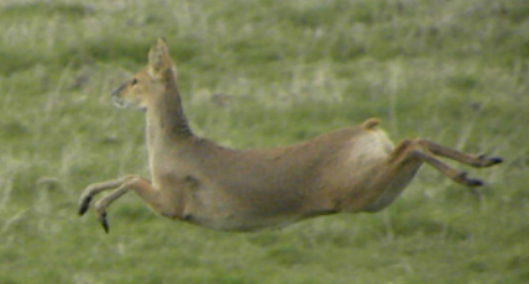
图5. 獐移动奔跑示意图(作者Sugoto Roy,来源IUCN)
Figure 5. Water deer jumping (contributor: Sugoto Roy; origin: IUCN)
7. 繁殖Reproduction
獐每年繁殖一次,11月至翌年1月左右交配,高峰期在12月,孕期约5-7个月,翌年5月底至7月底产仔。
每胎约2-3仔,也有产6仔的,甚至7仔。幼崽的身上有斑点(图6)。
Chinese water deer breed once a year. They mate from November to January of the next year, with mating peak in December. Pregnancy is about 5-7 months, fawns are born from the end of May to the end of July in the next year.
Each litter is about 2-3 fawns, some have 6, even 7. The fawn has spots on its body (Fig. 6).
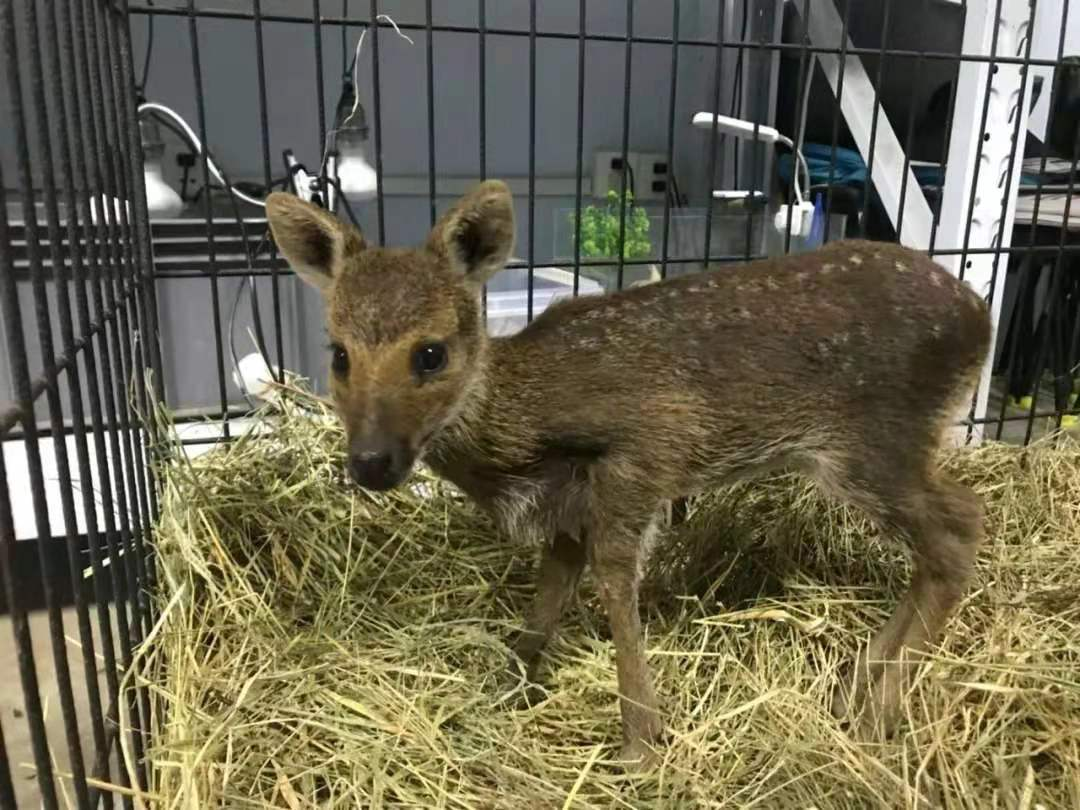
图6. 幼獐实体图(来源红山动物园)
Figure 6. The fawn of water deer (origin: Hongshan Zoo)
8. 保护现状Conservation Status
目前野外獐的种群处于减少的趋势,并且种群碎片化。生境改变及过度捕猎是导致獐数量下降,以至在一些地区绝迹的主要原因,江、湖沿岸人口密度不断增加,又是发展工农业生产的主战场。原来多高草丛和芦苇的湿地,大部分被垦为农田;残留芦苇,在冬季全部割尽,破坏了獐的栖息环境和隐蔽场所,加上农民为吃其肉而过量捕猎,其主要栖息地在平原、江湖岸边、海滩或低丘林缘,易被人追捕杀绝。
目前我国已经建立了鄱阳湖自然保护区、盐城自然保护区等保护区对獐进行保护。随着保护区环境的不断改善以及人民保护意识的提升,希望獐的种群数量可以达到稳定的状态。
At present, the population number of Chinese water deer in wild is decreasing, and the population distribution is fragmented. Habitat change and overhunting are the main reasons for the decline of Chinese water deer populations and even extinction in some areas. The human population density is increasing along the river and lake, which is also the main battlefield for the development of industrial and agricultural production. Most of the wetlands with tall grass and reeds were reclaimed for farmland; Residual reed are all cut in winter, which will destroy the habitat environment and hidden places of water deer. And farmers excessively hunt them for their meat. With main habitat in plains, rivers and lakes, beaches or low hilly edge, water deer is easy to be hunted and killed.
Nature reserves such as Poyang Lake Nature Reserve and Yancheng Nature Reserve have been established to protect Chinese water deer. With the continuous improvement of the environment and people's awareness of conservation, it is hoped that the population of Chinese water deer can reach a stable state.